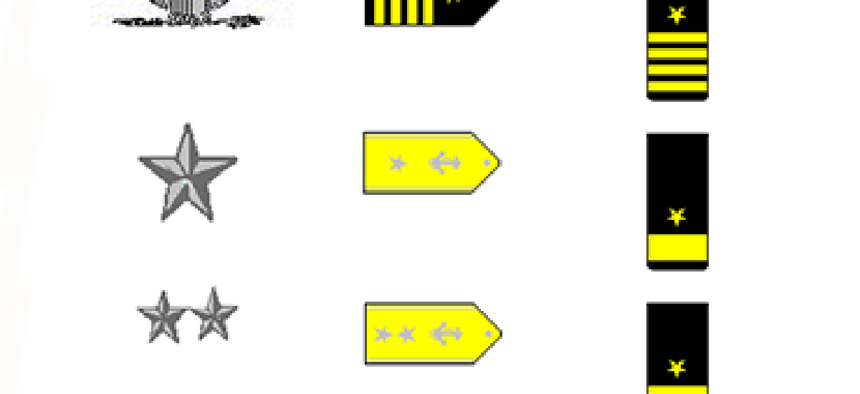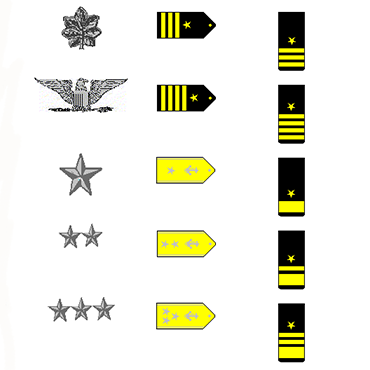Readers complain about 'brass creep'

The military's problems may be due in part to an overabundance of 'chiefs and supervisors,' FCW readers say.

Navy ranks are shown here, but the Navy is not the only service implicated in 'brass creep.'
FCW's July 31 story on the Pentagon's bleak response to a sweeping department-wide review drew multiple criticisms of Defense Department management. Readers called for members of Congress to be held accountable, for DOD to start from scratch and build a more enterprise-focused organization and for an overhaul in leadership structure. Some of the proposed solutions are more likely than others to be acted on, particularly the ones referring to changes in higher-level management.
An anonymous reader commented: You know they need to … quit having so many chiefs and supervisors. A supervisor should have at least 10 people under him, no different than a squad leader in the service. Too many head honchos and not enough worker bees. Need to look at all the agencies around the government and minimize top-heavy agencies.
Amber Corrin responds: A lot of people out there would agree – many arguments have been made against "brass creep," or the increasing number of high-ranking officers. This is not a new problem, though past efforts to deal with it have proven less than effective. But it looks like those efforts may be renewed in the latest round of Pentagon budget trimming.
On Aug. 1 Deputy Defense Secretary Ashton Carter released a memo directing a 20-percent reduction in Defense Department management headquarters spending over the next five fiscal years. The memo – which has been posted by the Project on Government Oversight, a watchdog group that has previously targeted brass creep – does not specify cuts aimed at the highest-ranking officials. But it "will apply to all higher headquarters staffs including Office of the Secretary of Defense principal staff assistants (PSAs) and their associated defense agency staffs, Joint Staff, service secretary staffs, service chief staffs, service 4-star major commands and service component commands, lower level service staffs (down to the appropriate level [determined] by the service secretaries and chiefs), and combatant command staffs."
The 20-percent cut applies to total headquarters budgets, but departments are directed to implement a goal of 20-percent reductions in government civilian staff as well as military personnel billets on staff. The cuts also will apply to related headquarters costs, including contract services, facilities, IT and other support functions.
The reductions are ordered regardless of the status of sequestration – including whether it continues into 2014. If that does happen, further cuts will have to be made, Carter warned in an Aug. 1 House Armed Services Committee hearing in which he took swipes at Congress and, perhaps inadvertently, the Obama administration of which he is a part.
"The things we have to do under sequestration are not strategic … they're dumb," Carter said. "This is not the result of an economic emergency or recession … [It is] purely the collateral damage of political gridlock, and potential enemies around the world are watching our behavior."





